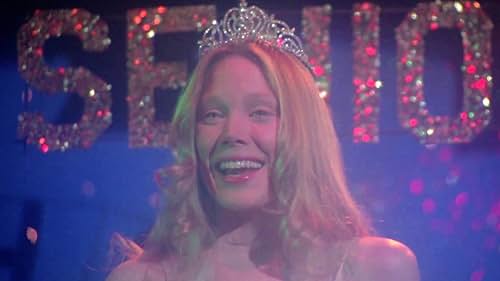Eye For Film >> Movies >> Carrie (1976) Film Review
Carrie
Reviewed by: Antoni Konieczny

There’s practically no fault in Brian De Palma’s Carrie, a landmark adaptation of Stephen King’s novel and one of the defining works of the New Horror cycle that emerged alongside New Hollywood. In this story of a 17-year-old girl trapped between a fanatically religious mother, bullying classmates, and the terrors of womanhood that she’s unequipped, at first, to navigate, the expressive potential of cinema becomes a presence as substantial as Carrie’s capacity for telekinesis.
The prologue spiritually anticipates Żuławski’s Possession - thanks to its disturbing, free-flowing wide-angle dollies - and is visually reminiscent of John D Hancock’s brilliant Let’s Scare Jessica To Death with its eerily idyllic soft light. Carrie (Sissy Spacek) gets her first period in the school shower and panics, unsure of what’s happening. Her classmates seize the moment for cruelty. Already within these first voyeuristic minutes, the supernatural surfaces, as does De Palma’s bravura visual eclecticism.

The remaining premise is dead simple. Penalised for the abuse, Carrie’s classmates scheme to get even with her via public humiliation. The story doesn’t keep us waiting for the main event long: the Prom with a capital-P. This sequence is to Carrie what the post-iceberg section is to Titanic; tragedy is foretold, but De Palma guides us to invest emotionally elsewhere, to keep rooting for Carrie. She makes a playful pact with the devil earlier, and so do we, surrendering to the director's choreography of spectatorship. One scene in particular is unforgettable: the camera swirls around Carrie and Tommy (William Katt), the popular boy who asked her to Prom, on the dance floor, not merely observing but pulling us into the rhythm, the dreaminess of it. It’s a pure, immersive moment that feels miraculous amid all the sweetly trashy sacrilege De Palma pioneers across the film.
The irreverent score, the gothic art direction, and Mario Tosi’s kaleidoscopic, slithering cinematography coalesce into something mesmeric. At one point, De Palma speeds up the footage and sound as Tommy and co. try on their Prom suits. It should come off as cheap and jarring. Instead, we’re so in sync with the film’s flow and confidence that we accept it without hesitation, and adore it for its audacity. This was one of those rare screenings at Warsaw's Timeless Film Festival with no guests, no Q&A, just a plain festival slot, that ended with a spontaneous ovation. That’s the enduring power of Carrie: a film so so alive with invention it stirs up astonishment, and love, decades on: the Prom Queen of the greatest decade in horror, still ruling.
Reviewed on: 13 Apr 2025















